Safe Food Sizes for Baby-Led Weaning
- Why small pieces of food are NOT safer and actually increase choking risk for early eaters
- How to prepare foods safely for baby-led weaning so that your baby doesn’t choke
- Which foods are best when you are starting baby-led weaning
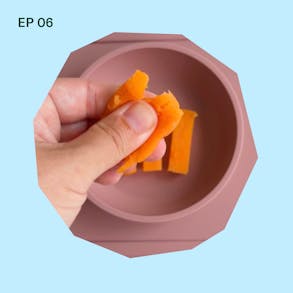
LISTEN TO THIS EPISODE
Episode Description
Contrary to common belief, cutting food into tiny pieces can actually heighten choking risk for early eaters. In this episode, learn why longer, spear-like shapes of soft foods (pinky finger size) are safer for self-feeding and other safe food cuts that reduce choking risk during the introduction of starting solid foods using baby-led weaning.
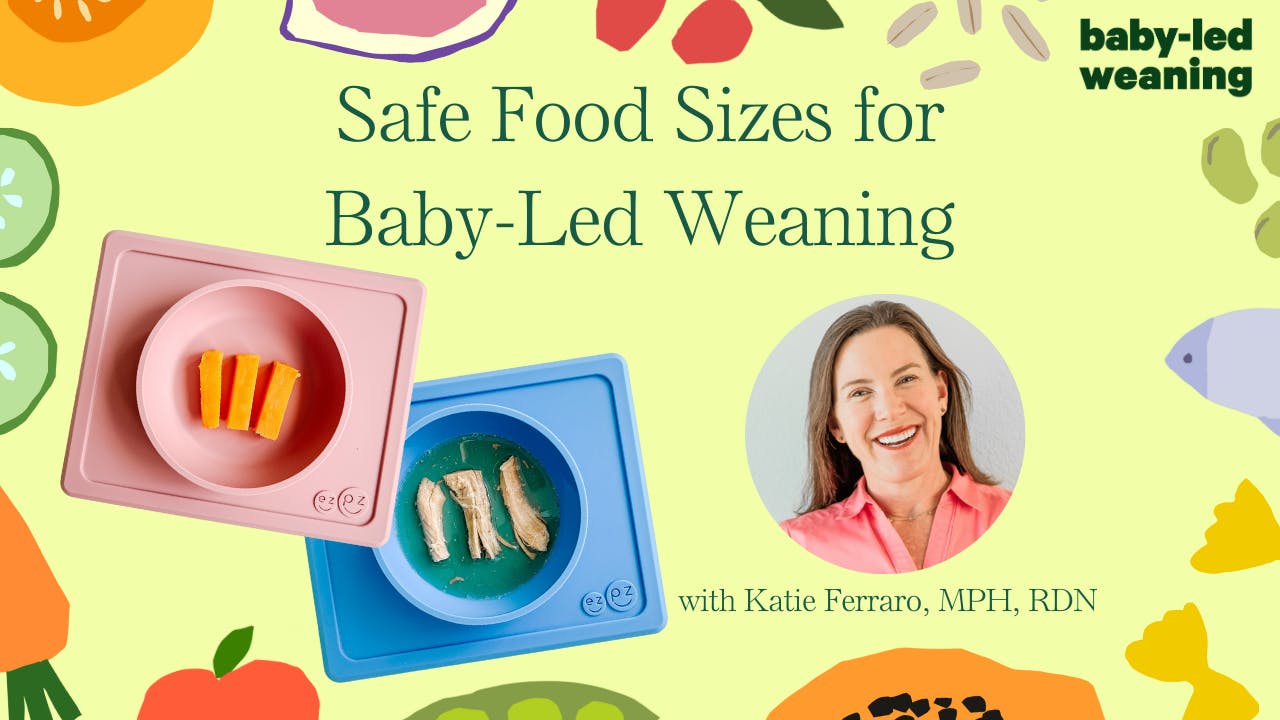
Links from This Episode
- Baby-Led Weaning with Katie Ferraro program with the 100 First Foods™ Daily Meal Plan, join here: https://babyledweaning.co/program
- Baby-Led Weaning for Beginners free online workshop with 100 First Foods™ list to all attendees, register here: https://babyledweaning.co/baby-led-weaning-for-beginners
Other Episodes Related to this Topic
- Episode 469 - Breaking Off a Small Bite: Is This a Choking Risk?
- Episode 386 - Pincer Grasp: When Can My Baby Pick Up Smaller Pieces of Food? with Rachel Harrington, COTA/L, AC
Resources and Research
- Committee on Injury, Violence, and Poison Prevention (2010). Prevention of choking among children. Pediatrics, 125(3), 601–607. https://doi.org/10.1542/peds.2009-2862
- Harris, C S et al. “Childhood asphyxiation by food. A national analysis and overview.” JAMA vol. 251,17 (1984): 2231-5.
- Rimell, F. L., Thome, A., Jr, Stool, S., Reilly, J. S., Rider, G., Stool, D., & Wilson, C. L. (1995). Characteristics of objects that cause choking in children. JAMA, 274(22), 1763–1766.

Latest Episodes
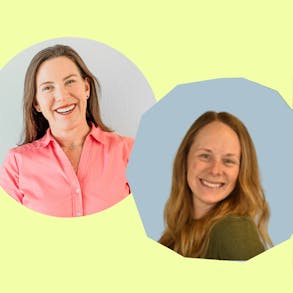
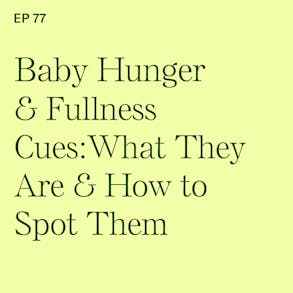

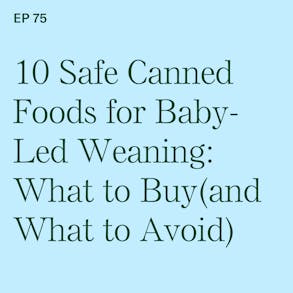
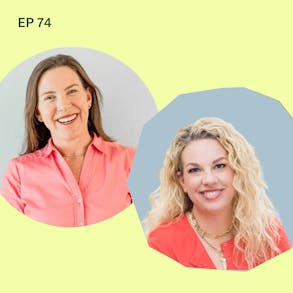
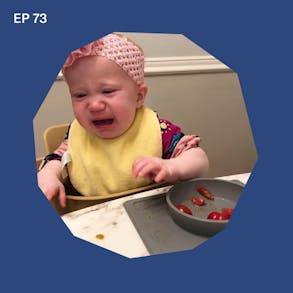
00:00:00.560 --> 00:00:02.960
<v SPEAKER_1>Look, Bumble knows you're exhausted by dating.
00:00:03.380 --> 00:00:12.380
<v SPEAKER_1>All the, Must not take yourself too seriously, and, 6'1, since that matters, and, What do I even say other than, hey?
00:00:14.320 --> 00:00:17.180
<v SPEAKER_1>Well, that's why they're introducing an all-new Bumble.
00:00:17.540 --> 00:00:22.660
<v SPEAKER_1>With exciting features to make compatibility easier, starting the chat better, and dating safer.
00:00:23.100 --> 00:00:25.020
<v SPEAKER_1>They've changed, so you don't have to.
00:00:25.460 --> 00:00:26.740
<v SPEAKER_1>Download the new Bumble now.
00:00:28.440 --> 00:00:30.940
<v SPEAKER_2>Do you find it hard to sleep at night?
00:00:31.260 --> 00:00:33.820
<v SPEAKER_2>Then the Sleep Cove Podcast can help you.
00:00:34.180 --> 00:00:40.980
<v SPEAKER_2>Hi, I'm Christopher Fitton, the voice and clinical hypnotherapist behind Sleep Cove.
00:00:41.720 --> 00:00:54.280
<v SPEAKER_2>Sleep Cove features sleep hypnosis, meditations and bedtime stories, all designed to help those of you who struggle at night to achieve a restful and peaceful night's sleep.
00:00:54.580 --> 00:01:03.900
<v SPEAKER_2>Search for Sleep Cove on Apple Podcasts or Spotify and see why Sleep Cove helps millions of people sleep deeply all night long.
00:01:08.560 --> 00:01:15.960
<v SPEAKER_3>So we don't offer smaller pieces of food to early eaters because when your baby starts solid foods, they don't have their pincer grasp, right?
00:01:15.980 --> 00:01:21.420
<v SPEAKER_3>Instead, they're going to use their whole hand or their palmar grasp to rake and scoop foods up and into their mouth.
00:01:21.440 --> 00:01:26.640
<v SPEAKER_3>And if you offered small pieces of food to your baby without their pincer grasp, they couldn't pick the food up.
00:01:26.660 --> 00:01:34.280
<v SPEAKER_3>So the assumption is that someone's placing the food in their mouth and putting anything in your baby's mouth, including a food or a spoon, can be a choking hazard.
00:01:34.960 --> 00:01:42.180
<v SPEAKER_3>Hey there, I'm Katie Ferraro, registered dietitian, college nutrition professor, and mom of seven specializing in Baby-Led Weaning.
00:01:42.500 --> 00:01:56.540
<v SPEAKER_3>Here on the Baby-Led Weaning with Katie Ferraro podcast, I help you strip out all of the noise and nonsense about feeding, giving you the confidence and knowledge you need to give your baby a safe start to solid foods using Baby-Led Weaning.
00:02:01.660 --> 00:02:11.340
<v SPEAKER_3>I remember the first time someone told me about Baby-Led Weaning and that babies eat pieces of food, like solid pieces of food, that are like as long as an adult pinky finger.
00:02:11.360 --> 00:02:20.980
<v SPEAKER_3>It kind of blew my mind because I always thought, if you cut it up really small, that's going to make it safer for the baby to eat.
00:02:21.500 --> 00:02:28.440
<v SPEAKER_3>But contrary to common belief, cutting food into really tiny pieces can actually heighten choking risk for early eaters.
00:02:28.620 --> 00:02:42.080
<v SPEAKER_3>So in this episode, we're going to talk about what type of food, what shape of food, what size of food, and even what texture of food is safest for early eaters as they're learning to feed themselves and also to reduce choking risk.
00:02:42.680 --> 00:02:48.400
<v SPEAKER_3>So I like to start each of these solo training episodes with a Baby-Led Weaning tip of the day.
00:02:48.740 --> 00:02:55.780
<v SPEAKER_3>And today's tip is that small pieces of food are not safe for your baby to eat in the beginning.
00:02:55.860 --> 00:02:57.200
<v SPEAKER_3>You'll get there, okay?
00:02:57.220 --> 00:03:04.720
<v SPEAKER_3>But in what I call phase one of Baby-Led Weaning, the first eight weeks after your baby starts solid foods, we're not doing little tiny pieces of food.
00:03:04.740 --> 00:03:11.400
<v SPEAKER_3>And hang tight, because in this episode, I'm going to explain why if you're doing Baby-Led Weaning, your baby can't even pick up those pieces of food.
00:03:11.420 --> 00:03:12.760
<v SPEAKER_3>So it's not really something you need to worry about.
00:03:12.780 --> 00:03:16.460
<v SPEAKER_3>What you do need to worry about is how to make the longer pieces of food safe.
00:03:16.920 --> 00:03:18.900
<v SPEAKER_3>So before we get there, I want to tell you a funny story.
00:03:18.920 --> 00:03:21.680
<v SPEAKER_3>So Baby-Led Weaning has its roots in the United Kingdom.
00:03:21.700 --> 00:03:28.780
<v SPEAKER_3>That's where Jill Rapley, the founder of the Baby-Led Weaning philosophy and the co-author of the original Baby-Led Weaning book, she's from the UK.
00:03:29.160 --> 00:03:53.280
<v SPEAKER_3>So when we talk about the proper size of Baby-Led Weaning foods, what I have evolved to say as a way to kind of avoid confusion is, I always talk about when we make foods about the size of your adult pinky finger, you'll be so sick of hearing about adult-sized pinky fingers, but if you want to skip the adult pinky finger, another analogy is you can think of the proper size of foods for early eaters for Baby-Led Weaning to be similar in size to a French fry.
00:03:53.620 --> 00:03:57.280
<v SPEAKER_3>Well, French fries, in British English, are called chips.
00:03:57.720 --> 00:04:13.180
<v SPEAKER_3>So Jill Rapley told me that when she brought this idea of Baby-Led Weaning to the United States, and she would mention making sticks of food the size of chips, American parents thought she meant tortilla chips or potato chips, and how do we make the food circular or triangular?
00:04:13.200 --> 00:04:19.640
<v SPEAKER_3>So I stick to the adult pinky finger size comparison, because I think everybody knows what that means.
00:04:19.660 --> 00:04:23.440
<v SPEAKER_3>But you could also say that pieces could be about the size of a French fry if you wanted.
00:04:23.820 --> 00:04:31.420
<v SPEAKER_3>So in this episode, I want to cover why size matters and then which size is best and safest for early eaters when you're doing Baby-Led Weaning.
00:04:31.800 --> 00:04:34.100
<v SPEAKER_3>I'll also talk about what the squish test is.
00:04:34.120 --> 00:04:38.840
<v SPEAKER_3>This is a nice benchmark for determining if a food is soft enough to offer to your baby.
00:04:39.200 --> 00:04:45.400
<v SPEAKER_3>And then I'll also share one of my favorite tips on how to soften fruits that aren't ripe enough to offer to your baby raw.
00:04:45.620 --> 00:04:48.180
<v SPEAKER_3>And that's because we do one new fruit each week.
00:04:48.300 --> 00:04:52.780
<v SPEAKER_3>So in my five-step feeding framework, we're introducing five new foods each week to your baby.
00:04:53.000 --> 00:04:56.520
<v SPEAKER_3>And our goal is working towards a hundred foods before your baby turns one.
00:04:56.800 --> 00:05:00.540
<v SPEAKER_3>And so the five foods you offer each week, they come off of my hundred first foods list.
00:05:00.900 --> 00:05:02.240
<v SPEAKER_3>On Monday, we do a new fruit.
00:05:02.520 --> 00:05:04.100
<v SPEAKER_3>On Tuesday, we do a new vegetable.
00:05:04.360 --> 00:05:06.200
<v SPEAKER_3>On Wednesday, we do a new starchy food.
00:05:06.460 --> 00:05:08.220
<v SPEAKER_3>On Thursday, we do a new protein food.
00:05:08.240 --> 00:05:10.200
<v SPEAKER_3>And on Friday, we do an allergenic food.
00:05:10.580 --> 00:05:15.760
<v SPEAKER_3>And so when it comes to the fruits, and his parents are like, well, I got this mango and I'm ready to do mango, but the mango is not soft enough.
00:05:16.000 --> 00:05:18.680
<v SPEAKER_3>I'll teach you how to poach the fruits to make them soft enough.
00:05:18.700 --> 00:05:19.680
<v SPEAKER_3>It's super easy.
00:05:19.980 --> 00:05:23.160
<v SPEAKER_3>And it helps you kind of stay on track with doing those five foods a week.
00:05:23.560 --> 00:05:30.540
<v SPEAKER_3>If you'd like to grab a copy of my hundred first foods list, it's a really nice way to never run out of foods and ideas of foods your baby can eat.
00:05:30.800 --> 00:05:38.140
<v SPEAKER_3>I give away my hundred first foods list to everybody for free on my online workshop called Baby-Led Weaning for Beginners.
00:05:38.480 --> 00:05:43.060
<v SPEAKER_3>This is a video workshop where I show you how to shape all these foods, because in this episode, I'll talk about it.
00:05:43.200 --> 00:05:55.400
<v SPEAKER_3>But if you actually want to see what the foods look like and get some ideas for the first two weeks of Baby-Led Weaning, and grab your copy of that hundred first foods list, again, it's all on the free online video workshop called Baby-Led Weaning for Beginners.
00:05:55.640 --> 00:05:58.940
<v SPEAKER_3>And you can sign up for that at babyledweaning.co.
00:05:58.960 --> 00:05:59.960
<v SPEAKER_3>slash workshop.
00:06:00.420 --> 00:06:02.700
<v SPEAKER_3>So let's look first at why size matters.
00:06:02.880 --> 00:06:08.500
<v SPEAKER_3>So when it comes to giving your baby a safe start to solid foods, the size of the food that you offer matters.
00:06:08.800 --> 00:06:16.260
<v SPEAKER_3>And the safest size of food for Baby-Led Weaning are soft pieces of food that are shaped about the size of your adult pinky finger.
00:06:16.560 --> 00:06:23.060
<v SPEAKER_3>So before we get more into the longer pieces of food, I just want to explain why we don't offer smaller pieces of food to early eaters.
00:06:23.620 --> 00:06:27.880
<v SPEAKER_3>So when your baby starts solid foods, they don't yet have their pincer grasp.
00:06:28.160 --> 00:06:34.240
<v SPEAKER_3>So instead, your baby uses their whole hand or their palmar grasp to rake and scoop foods up and into their mouth.
00:06:34.640 --> 00:06:40.440
<v SPEAKER_3>So if you offered small pieces of food to your baby without their pincer grasp, they couldn't pick the food up yet.
00:06:40.480 --> 00:06:44.460
<v SPEAKER_3>So the assumption would be there that someone is placing the food in their mouth.
00:06:44.660 --> 00:06:49.780
<v SPEAKER_3>And putting anything in a baby's mouth, including food or a spoon, that can be a choking hazard.
00:06:50.120 --> 00:07:00.940
<v SPEAKER_3>So even if the baby could get that small piece of food in their mouth, which we've determined early eaters without their pincer grasp cannot, then the small piece of food is the exact size that could potentially occlude your baby's airway.
00:07:01.380 --> 00:07:07.360
<v SPEAKER_3>So instead, we offer longer pieces of food shaped about the size of your adult pinky finger.
00:07:07.600 --> 00:07:14.480
<v SPEAKER_3>Again, you're going to be so tired of hearing the phrase adult pinky finger as you move through Baby-Led Weaning, but it's a really good visual for you.
00:07:14.500 --> 00:07:22.220
<v SPEAKER_3>Like, ah, that's about the size that my baby can pick up with still enough room so that they can get that little piece of food into their mouth.
00:07:22.240 --> 00:07:28.080
<v SPEAKER_3>Because the saddest thing is sometimes a baby gets a food in their little tight claw, and then they can't get it out of there.
00:07:28.100 --> 00:07:34.260
<v SPEAKER_3>So we cut the longer pieces so that they have something to hold on to, but also some of the food sticking up so they can actually bite off that food.
00:07:34.480 --> 00:07:37.060
<v SPEAKER_3>Hey, we're going to take a quick break, but I'll be right back.
00:07:46.735 --> 00:07:49.275
<v SPEAKER_4>Hey there, I'm Dylan Lewis, one of the hosts of Motley Fool Money.
00:07:49.635 --> 00:07:54.935
<v SPEAKER_4>Each weekday on Motley Fool Money, we talk through the business news you need to know and the stories moving stocks on Wall Street.
00:07:55.355 --> 00:08:01.015
<v SPEAKER_4>On weekends, we dive into the industries shaping tomorrow and host the experts, authors, and executives that understand them.
00:08:01.415 --> 00:08:06.095
<v SPEAKER_4>Tune in for insights, a long-term perspective on investing, and of course, stock ideas, plenty of them.
00:08:06.395 --> 00:08:08.015
<v SPEAKER_4>To quote a listener, it pays to listen.
00:08:08.375 --> 00:08:10.755
<v SPEAKER_4>Check us out and subscribe wherever you listen to podcasts.
00:08:17.609 --> 00:08:19.089
<v SPEAKER_3>Now, what about the squish test?
00:08:19.409 --> 00:08:23.629
<v SPEAKER_3>So when you're preparing foods for Baby-Led Weaning, it's important that the foods are soft.
00:08:23.909 --> 00:08:28.669
<v SPEAKER_3>So we don't want to offer any hard or crunchy or crispy foods to early eaters.
00:08:29.169 --> 00:08:35.229
<v SPEAKER_3>And whether or not your baby does or does not have teeth, that actually has no bearing on their readiness to start solid foods.
00:08:35.729 --> 00:08:43.529
<v SPEAKER_3>So when it comes to the soft foods, it's important that the strips of finger foods that we offer to your baby pass what's called the squish test.
00:08:43.989 --> 00:08:49.569
<v SPEAKER_3>I love giving credit where credit is due, but I do not know who originated the term, the squish test, or I would give them credit.
00:08:49.589 --> 00:08:56.629
<v SPEAKER_3>But basically, it's when you press the cooked or ripe food between your forefinger and your thumb, there should be a little give.
00:08:56.709 --> 00:08:59.409
<v SPEAKER_3>Okay, we don't want the food snapping or crunching.
00:08:59.669 --> 00:09:02.329
<v SPEAKER_3>It's got to be soft so your baby can safely swallow it.
00:09:02.589 --> 00:09:05.609
<v SPEAKER_3>And one example of this I'll share with you are for bell peppers.
00:09:05.629 --> 00:09:10.289
<v SPEAKER_3>So bell peppers are one of the foods that are in the vegetable part of the 100 First Foods list.
00:09:10.309 --> 00:09:13.409
<v SPEAKER_3>And parents are like, oh, just cut up the raw bell pepper and give it to the baby.
00:09:13.429 --> 00:09:14.669
<v SPEAKER_3>Like, no, no, no, no, no.
00:09:14.829 --> 00:09:19.469
<v SPEAKER_3>So inside of my program, we have videos that show you how to make all of the different fruits and vegetables, foods, et cetera, safe.
00:09:19.709 --> 00:09:30.869
<v SPEAKER_3>And for bell pepper, you can roast your own bell peppers, you can remove the skin, and then when it's nice and soft and shreds easily between your finger and your thumb, that's when you can offer it to your baby.
00:09:31.369 --> 00:09:41.589
<v SPEAKER_3>And if you don't want to deal with roasting your own bell peppers, because I get it, that is very labor-intensive and time-consuming, roasted, jarred red bell peppers, you can find them that are quite low in sodium.
00:09:41.609 --> 00:09:47.549
<v SPEAKER_3>My general rule of thumb for Baby-Led Weaning is I'm looking for less than 100 milligrams of sodium per serving of a food that I'm going to offer the baby.
00:09:47.849 --> 00:09:52.629
<v SPEAKER_3>Roasted red bell pepper strips are so easy, they're awesome, and babies freaking love them.
00:09:53.009 --> 00:09:54.989
<v SPEAKER_3>They're nice and soft, you don't have to do the roasting.
00:09:55.009 --> 00:10:00.829
<v SPEAKER_3>If they have any of the black charred part on them, sometimes the fire-roasted ones, I'll pick that off, because again, we don't want any crunchy or crispy parts.
00:10:00.989 --> 00:10:04.209
<v SPEAKER_3>Those nice, soft red bell pepper strips, babies love to eat those.
00:10:04.789 --> 00:10:13.389
<v SPEAKER_3>Also, we have a recipe inside of our program for romesco sauce, so it's a red bell pepper sauce, and this is awesome, because it also includes almonds, which is a tray nut.
00:10:13.569 --> 00:10:19.669
<v SPEAKER_3>So it's an easy way to introduce your baby to one of the potentially allergenic foods, tray nut, while at the same time doing bell pepper.
00:10:19.689 --> 00:10:24.969
<v SPEAKER_3>And it's totally safe to introduce more than one new food at a time or in a day, just in case you're wondering.
00:10:25.129 --> 00:10:28.049
<v SPEAKER_3>We just don't do two new allergenic foods at the same time.
00:10:28.389 --> 00:10:39.749
<v SPEAKER_3>So if you want to follow my 100 First Foods Daily Meal Plan and make all these foods for your baby and watch videos on how you make them safe, that's all inside of my program, called Baby-Led Weaning With Katie Ferraro.
00:10:40.209 --> 00:10:42.229
<v SPEAKER_3>It's got the 100 First Foods Daily Meal Plan.
00:10:42.249 --> 00:10:46.849
<v SPEAKER_3>It's got videos, instructions for all the 100 foods and how to make them safe for the different ages and stages.
00:10:46.869 --> 00:10:52.529
<v SPEAKER_3>Because as your baby gets older, you'll feel more comfortable doing the variety of textures, especially with foods like bell pepper.
00:10:52.549 --> 00:10:54.529
<v SPEAKER_3>But we don't do those, especially for early eaters.
00:10:54.869 --> 00:10:58.569
<v SPEAKER_3>So if you want to learn more about the program, it's online at babyledweaning.co.
00:10:59.089 --> 00:10:59.569
<v SPEAKER_3>program.
00:11:00.129 --> 00:11:04.409
<v SPEAKER_3>So when you're thinking about the squish test, I'll give you an example of mango, another one.
00:11:04.429 --> 00:11:05.989
<v SPEAKER_3>You get a super ripe mango, okay?
00:11:06.529 --> 00:11:13.969
<v SPEAKER_3>If you have a super ripe mango and you remove the skin and you cut the fruit off the pit, you can offer the very soft strips of mango to your baby.
00:11:13.989 --> 00:11:17.249
<v SPEAKER_3>But other times, you'll have mango that's like rock hard, okay?
00:11:17.269 --> 00:11:18.869
<v SPEAKER_3>But you can't feed that to your baby.
00:11:18.989 --> 00:11:20.549
<v SPEAKER_3>But you're like, wait a minute, I was going to do mango this week.
00:11:20.569 --> 00:11:21.449
<v SPEAKER_3>That's my new fruit of the week.
00:11:21.469 --> 00:11:27.189
<v SPEAKER_3>Well, you can modify a food like mango, many fruits, to make it soft and safer for your baby.
00:11:27.209 --> 00:11:28.609
<v SPEAKER_3>And we do that by poaching.
00:11:29.229 --> 00:11:31.749
<v SPEAKER_3>So let's talk next about poaching foods.
00:11:32.149 --> 00:11:35.969
<v SPEAKER_3>Poaching is simply the act of heating food submerged in a liquid.
00:11:35.989 --> 00:11:39.069
<v SPEAKER_3>So that can be water or milk or no-salt broth.
00:11:39.149 --> 00:11:48.589
<v SPEAKER_3>And just be aware that poaching is a little bit different than other moist heat cooking methods, because you usually do it at a lower temperature than boiling, let's say.
00:11:49.049 --> 00:11:52.829
<v SPEAKER_3>Some of the foods from the 100 First Foods list, if you boil them, it doesn't work.
00:11:52.849 --> 00:11:57.969
<v SPEAKER_3>You're going to blow them to smithereens, and then your baby won't be able to pick them up with their fingers like a cucumber, right?
00:11:58.229 --> 00:12:02.369
<v SPEAKER_3>Like, we don't offer raw cucumber to early eaters in phase one of Baby-Led Weaning.
00:12:02.389 --> 00:12:04.789
<v SPEAKER_3>That's the first eight weeks of Baby-Led Weaning.
00:12:05.089 --> 00:12:09.029
<v SPEAKER_3>If cucumber is not ripe enough, you can poach it to soften it.
00:12:09.029 --> 00:12:11.289
<v SPEAKER_3>Okay, but you don't boil cucumbers, right?
00:12:11.309 --> 00:12:12.029
<v SPEAKER_3>It's not really a thing.
00:12:12.049 --> 00:12:16.289
<v SPEAKER_3>So you want to get it nice and tender so it passes that squish test.
00:12:16.309 --> 00:12:19.369
<v SPEAKER_3>And just as an aside, you can definitely use the pulverized foods.
00:12:19.389 --> 00:12:23.589
<v SPEAKER_3>Like, I boil poached stuff way too long, forget about it, leave it on the stove like, oh crap, now it's a puree.
00:12:24.109 --> 00:12:30.849
<v SPEAKER_3>If you have those foods and you want to offer them as a puree for your baby to practice self-feeding by spoon, you definitely can do that, right?
00:12:30.869 --> 00:12:37.849
<v SPEAKER_3>You can take the preloaded spoon, you can put the pureed food in the bowl of it, offer it to your baby, and allow it to feed it to themselves.
00:12:37.869 --> 00:12:42.809
<v SPEAKER_3>And in the previous episode, I talked about my purees for a few days approach.
00:12:42.829 --> 00:12:49.849
<v SPEAKER_3>If you have questions about incorporating purees using Baby-Led Weaning, go listen to that episode, blwpodcast.com forward slash five.
00:12:50.069 --> 00:12:58.129
<v SPEAKER_3>But just so you know, moving forward in Baby-Led Weaning, you do not have to go pureeing foods that you could otherwise offer in a soft finger food fashion.
00:12:58.549 --> 00:13:05.249
<v SPEAKER_3>In summary, the safest size of foods for Baby-Led Weaning are foods that are shaped about the size of your adult pinky finger.
00:13:05.269 --> 00:13:06.729
<v SPEAKER_3>You could also call that our French fry.
00:13:06.749 --> 00:13:10.209
<v SPEAKER_3>If you're British, it's a chip, but we're not talking tortilla chips or potato chips.
00:13:10.649 --> 00:13:19.689
<v SPEAKER_3>If you want to see more videos as to what the first few days of Baby-Led Weaning looks like and learn a little bit more about this approach, come take my free online workshop, Baby-Led Weaning for Beginners.
00:13:19.929 --> 00:13:28.369
<v SPEAKER_3>Or if you're ready to dive in with 100 First Foods Challenge and get your baby eating those five new foods a week, I'll show you exactly how to prepare all those foods safely.
00:13:28.549 --> 00:13:31.689
<v SPEAKER_3>That's inside of my Baby-Led Weaning With Katie Ferraro program.
00:13:31.969 --> 00:13:35.649
<v SPEAKER_3>Both of those resources are linked up for you at babyledweaning.co.
00:13:35.889 --> 00:13:41.709
<v SPEAKER_3>And I'll put everything from this episode on the show notes, which you can find at blwpodcast.com forward slash six.
00:13:42.149 --> 00:13:44.969
<v SPEAKER_3>I want to say a special thank you to our partners at Airwave Media.
00:13:45.209 --> 00:13:50.709
<v SPEAKER_3>If you like podcasts that feature food and science and using your brain, check out some of the shows from Airwave Media.
00:13:50.949 --> 00:13:53.049
<v SPEAKER_3>We're online at babyledweaning.co.
00:13:53.789 --> 00:13:55.829
<v SPEAKER_3>Thanks so much for listening, and I'll see you next time.
00:14:04.607 --> 00:14:12.307
<v SPEAKER_5>Have you ever wished that you had a direct line to your pediatrician to ask all the questions that constantly crop up while parenting?
00:14:12.667 --> 00:14:13.567
<v SPEAKER_5>We sure have.
00:14:14.047 --> 00:14:17.407
<v SPEAKER_5>That's why we launched the Bites of Health podcast.
00:14:17.907 --> 00:14:23.187
<v SPEAKER_5>Every morning, we'll answer a commonly asked pediatric question in five minutes or less.
00:14:23.567 --> 00:14:28.467
<v SPEAKER_5>You can tune in while you're making your second cup of coffee or from the school drop-off line.
00:14:28.827 --> 00:14:33.047
<v SPEAKER_5>So be sure to tune in to Bites of Health, streaming now.
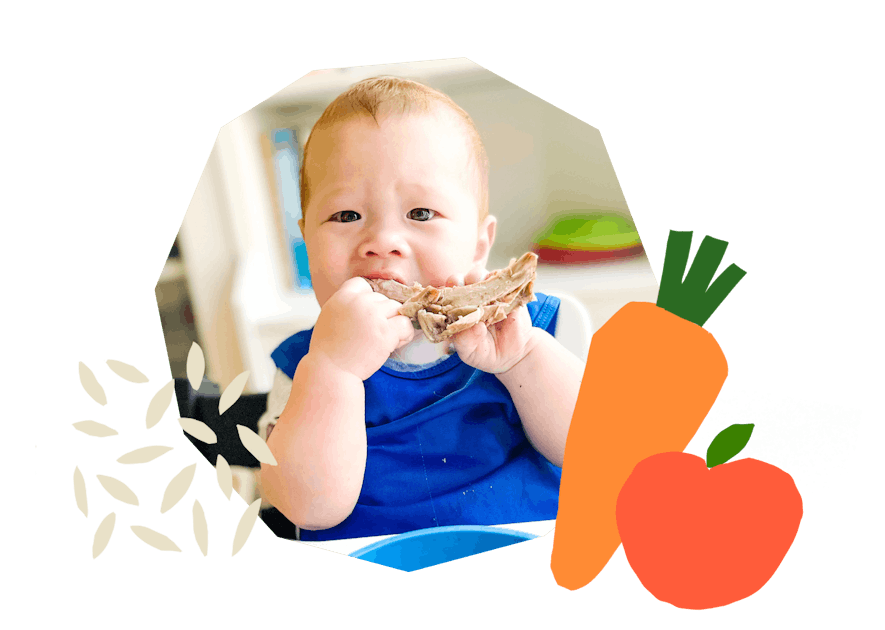
The Program Baby-Led Weaning with Katie Ferraro
A step-by-step digital program for starting solid foods safely and navigating the original 100 FIRST FOODS™ meal plan with baby-led weaning.
 EXPERT-LED, PROVEN APPROACH TO EATING REAL FOOD
EXPERT-LED, PROVEN APPROACH TO EATING REAL FOOD CONCISE VIDEO TRAININGS TO MASTER BABY-LED WEANING
CONCISE VIDEO TRAININGS TO MASTER BABY-LED WEANING 100 FIRST FOODS DAILY MEAL PLAN WITH FOOD PREP VIDEOS
100 FIRST FOODS DAILY MEAL PLAN WITH FOOD PREP VIDEOS
Baby-Led Weaning for Beginners Free Workshop
Is your baby ready to start solid foods, but you’re not sure where to start? Get ready to give your baby a solid foundation to a lifetime of loving real food…even if you’re feeling overwhelmed or confused about this next stage of infant feeding.
Get baby-led weaning recipes and tips delivered to your email inbox.

